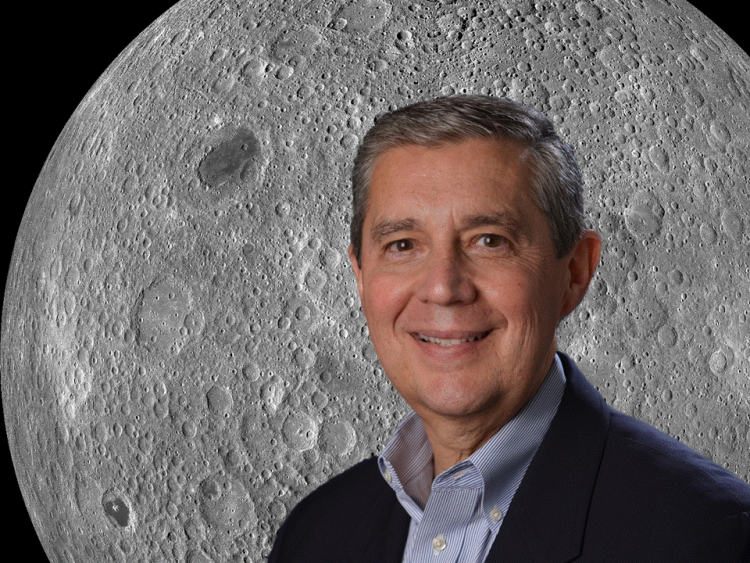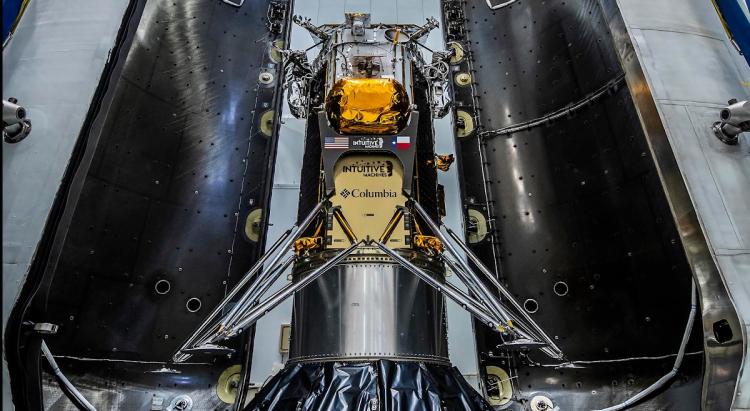Radio Telescope with CU Boulder Affiliation Set to Land at Moon’s South Pole
Astrophysicists at CU Boulder will be part of the first United States science payloads to land on the moon since Apollo 17 in 1972. Their data could help reveal the sheath of charged particles that lies just above the moon, potentially giving the lunar surface a small electrical charge like a sweater coming out of the dryer.
The effort is one piece of the first mission in NASA’s Commercial Lunar Payload Services (CLPS) initiative—in which the space agency is, “working with several American companies to deliver science and technology to the lunar surface.” In mid-February, a NOVA-C lander designed and built by the Houston-based company Intuitive Machines is scheduled to launch for the moon’s South Pole. The vehicle will carry five NASA-funded scientific payloads, including an instrument called Radio wave Observations at the Lunar Surface of the photo Electron Sheath (ROLSES).
CU Boulder astrophysicist Jack Burns is a co-investigator on the ROLSES instrument, which is led by Natchimuthuk Gopalswamy at NASA’s Goddard Space Flight Center in Greenbelt. Burns and his students at CU Boulder are counting down the days.
“We are going to the surface of the moon for the first time in over 50 years,” said Burns, professor emeritus in the Department of Astrophysical and Planetary Sciences.
ROLSES may look modest in size and mass. The instrument is made up of four radio monopole antennas and associated electronics that together weigh about 30 pounds.
The team will use these simple tools to collect the first measurements of the electrical charges that scientists suspect hover above the moon’s surface—and which could create hazards for future moon explorers. The researchers also hope to do something even more ambitious: observe radio waves emanating from around the Earth as if our planet was orbiting a star much farther away.
“We’re going to look at Earth like it’s an exoplanet,” Burns said. “We want to understand what a habitable planet might look like at radio frequencies from 30 light-years away.”
ROLSES will also observe various types of radio bursts generated in the interplanetary medium by high-energy electrons accelerated by solar eruptions.
“We have an opportunity to observe radio signatures of electron beams and shock waves leaving the Sun that may adversely impact Earth,” said Gopalswamy, who works in the heliophysics science division at NASA’s Goddard Space Flight Center. “ROLSES will be a pathfinder in setting up future radio observatories on the moon.”
Returning to the moon
When the lander, which is named Odysseus, alights on the moon on Feb. 22, it will encounter an environment unlike any on Earth.
ROLSES co-investigator Bill Farrell, a scientist at the Space Science Institute, explained that charged electrons and protons in the solar wind, or the stream of radiation coming from the sun, beat down on the moon’s polar regions. Scientists suspect that this bath will charge up the lunar surface negatively, leaving a deficit of electrons in the region just above the surface.
The lack of electrons in this sheath might also pose a risk to astronauts. As explorers cross over the lunar soil from sunlight to the moon’s nightside, they may build up charges on their space suits—an effect that is bit like what happens if you touch a metal doorknob after walking on a carpet.
NASA is currently planning to send humans back to the moon later this decade through the Artemis program.
“In the Apollo era, the astronauts were always in daylight, so this wasn’t much of an issue,” Burns said. “But if you’re going from daylight to, say, a permanently shadowed crater, you could create some substantial electrical currents.”
ROLSES will collect measurements of the moon’s electron sheath for the first time, revealing just how dense these regions might be.
The instrument’s four antennas will also look up. Burns noted that Earth produces a constant surge of radio waves—both through natural processes and the churn of cell towers and other human technologies. ROLSES will begin to map out those signals from hundreds of thousands of miles away, obtaining a sort of space radio selfie of our planet.
Just the beginning
For the astrophysicist, the mission, while modest, is a first step in his decades-long quest to conduct astrophysics on the moon. Burns and his colleagues are developing a plan to lay out more than 75 square miles of radio antennas not unlike those on ROLSES across the moon’s far side facing away from Earth. These antennas will be so precise that they may pick up the faint signals left behind in the universe from the Big Bang 13.8 billion years ago.
Burns and his colleagues also plan to follow ROLSES with another instrument called the Lunar Surface Electromagnetics Experiment at Night (LuSEE-Night). It is manifested to land on the far side of the moon in 2026 as part of a later CLPS flight.
“LuSEE will probe for the first time the unexplored ‘Dark Ages’ of the early universe,” Burns said, “just before the formation of the first stars where new exotic physics concerning, for example, dark matter might be revealed.”



